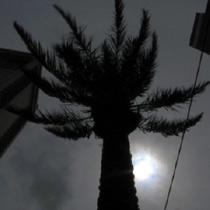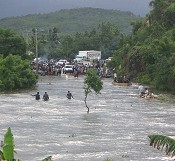-
(单词翻译:双击或拖选)
This is SCIENCE IN THE NEWS in VOA Special English. I’m Bob Doughty1.
VOICE TWO:
And I’m Barbara Klein. Our subject today: severe ocean storms.
(MUSIC)
VOICE ONE:
 September is usually the worst month for hurricanes in the Atlantic Ocean. At least ten named storms have formed there this year. The hurricane season continues until the end of November.
September is usually the worst month for hurricanes in the Atlantic Ocean. At least ten named storms have formed there this year. The hurricane season continues until the end of November. The total number of major storms this year has been above average. There were three major hurricanes in the Atlantic Ocean. The latest hurricane to strike land was called Hurricane Ike. It was a huge storm, stretching out across a thousand kilometers when it struck the southern coast of the United States last month.
Hurricane Ike caused major flooding and destroyed thousands of homes. It also left millions of people without power in Texas. The storm killed at least thirty people in nine states.
 |
| Flooding in Miragoane, Haiti, after hurricanes Gustav and Ike |
The situation was even worse in the nation of Haiti, which has been severely2 damaged by several storms this year.
VOICE TWO:
About ninety ocean storms form each year around the world. These powerful storms are called hurricanes when they form in the Atlantic Ocean and the eastern Pacific Ocean. They are called typhoons in the northwestern Pacific, and cyclones3 when they develop in the Indian Ocean. Severe ocean storms in the northern half of the world generally develop in late summer or early autumn near the equator4.
Storms can result when the air temperature in one area is different from that of another. Warmer air rises and cooler air falls. These movements create a difference in the pressure of the atmosphere. If the pressure changes over a large area, winds start to blow in a huge circle. High-pressure air is pulled toward5 a low-pressure center.
VOICE ONE:
Severe ocean storms happen less often in the southern hemisphere6. There, the season of greatest activity is between December and March. South of the equator, the winds flow in the same direction as the hands on a clock. North of the equator, they flow in the opposite direction.
(MUSIC)
VOICE TWO:
Storms can get stronger as they move over warm ocean waters. The strongest, fastest winds of a hurricane are found in the eyewall. This is the area that surrounds the center, or eye, of the storm. The eye itself is calm by comparison7, with light winds and clear skies.
Wind speeds in severe ocean storms can reach more than two hundred fifty kilometers an hour. Up to fifty centimeters of rain can fall. Some storms have produced more than one hundred fifty centimeters of rain.
These storms also cause high waves and ocean surges9. A surge8 is a continuous10 movement of water that may reach six meters or more. The water strikes low coastal11 areas. Surges are commonly responsible for about ninety percent of all deaths from ocean storms.
VOICE ONE:
Scientists use computer programs to show where a storm might go. The programs combine information such as temperatures, wind speed, atmospheric12 pressure and the amount of water in the atmosphere.
Scientists collect the information with satellites, weather balloons and devices13 floating in the world's oceans. They also collect information from ships and passenger flights and from airplanes that fly in and around storms. The crews drop instruments on parachutes to record temperature, pressure, wind speed and other conditions.
VOICE TWO:
The Saffir-Simpson Hurricane Scale is a way to rate storms based on wind speed. It provides an idea of the amount of coastal flooding and property damage that might be expected.
The scale is divided into five groups. A category one storm has winds of about one hundred twenty to one hundred fifty kilometers an hour. It can damage trees and lightweight structures. It can also cause flooding.
Wind speeds in a category two hurricane can reach close to one hundred eighty kilometers an hour. These storms are often powerful enough to break windows or blow a protective14 covering off a house. Winds between about one hundred eighty and two hundred fifty kilometers an hour represent categories three and four. Anything even more powerful is a category five hurricane.
(MUSIC)
VOICE ONE:
The major hurricanes that formed in the Atlantic Ocean this year were called Gustav, Hanna and Ike. How did they get these names?
An Australian scientist began to call storms by women's names before the end of the nineteenth century. During World War Two, scientists called storms by the names of their wives or girlfriends.
The weather service in the United States started to use women’s names for storms in nineteen fifty-three. In nineteen seventy-nine, it began to use men’s names, too. Scientists decide on lists of names years in advance. They agree on them at meetings of the World Meteorological Organization.
VOICE TWO:
Naming storms is part of the job of the National Hurricane Center in Florida. Storms get a name when they reach a wind speed of sixty-two kilometers an hour, even if they never develop into hurricanes. The first name used in a storm season begins with the letter A, the second with B and so on. The same list of names is not used again for at least six years. And different lists are used for different parts of the world.
VOICE ONE:
Three years ago, Greek letters had to be used for the first time to name storms in the Atlantic. That was the plan -- to call storms Alpha, Beta and so on -- if there were ever more than twenty-one named storms in a season. In fact, there were twenty-eight. The two thousand five Atlantic hurricane season was the first on record with fifteen hurricanes. Four hurricanes reached category five strength -- also a first.
The National Oceanic and Atmospheric Administration15 says it was the first season with four major hurricanes to strike the United States. The most destructive16 was Katrina. More than one thousand eight hundred people were killed along the Gulf17 of Mexico coast.
(MUSIC)
VOICE TWO:
Debate continues about the effect of rising temperatures in Earth's atmosphere on hurricanes. A new report says ocean storms are growing in strength and climate might be to blame. Scientists from Florida State University and the University of Wisconsin reported their findings18 last month in Nature magazine.
The scientists say the most powerful ocean storms are becoming more intense19. They found that the strongest hurricanes and typhoons have become even stronger over the past twenty-five years.
The lead writer of the report was James Elsner of Florida State University. He says there is a good chance of more category four and five hurricanes in the future because ocean temperatures are expected to continue rising.
VOICE ONE:
The scientists studied weather satellite information from nineteen eighty-one through two thousand six. During the period, ocean surface temperatures increased by an average of a third of a degree Celsius20.
The scientists found that this change has fueled the increase in hurricane intensity21. They also found that the highest wind speeds of the strongest storms averaged two hundred fifty-three kilometers an hour in two thousand six. This is an increase from two hundred twenty-five kilometers an hour in nineteen eighty-one. The increases in intensity were greatest in the Atlantic Ocean.
VOICE TWO:
Last year, other scientists found that the number of Atlantic hurricanes increased one hundred percent over the past century. Greg Holland and Peter Webster studied records of major storms in the North Atlantic.
Mister22 Holland works23 for the National Center for Atmospheric Research. He says the study provided24 strong evidence that climate change is a major influence on the increasing number of Atlantic hurricanes.
VOICE ONE:
However, not everyone agrees that climate change is causing more severe ocean storms. Jeffrey Halverson is a hurricane expert at the University of Maryland. He says there is probably a link to climate change but it has been difficult to find.
Christopher Landsea is with the National Hurricane Center. He says he believes climate change has a small influence on hurricanes. He argues that stronger storms are the result of changes in climate and natural weather cycles. But other experts say wind speeds will increase in the strongest storms for the next several years.
(MUSIC)
VOICE TWO:
This SCIENCE IN THE NEWS was written by Shelley Gollust. Our producer was Brianna Blake. I'm Barbara Klein.
VOICE ONE:
And I’m Bob Doughty. Listen again next week for more news about science in Special English on the Voice of America.
 收听单词发音
收听单词发音
1
doughty

|
|
| adj.勇猛的,坚强的 | |
参考例句: |
|
|
|
2
severely

|
|
| adv.严格地;严厉地;非常恶劣地 | |
参考例句: |
|
|
|
3
cyclones

|
|
| n.气旋( cyclone的名词复数 );旋风;飓风;暴风 | |
参考例句: |
|
|
|
4
equator

|
|
| n.赤道,(平分球形物体的面的)圆 | |
参考例句: |
|
|
|
5
toward

|
|
| prep.对于,关于,接近,将近,向,朝 | |
参考例句: |
|
|
|
6
hemisphere

|
|
| n.半球,半球地图 | |
参考例句: |
|
|
|
7
comparison

|
|
| n.比较,对照;比拟,比喻 | |
参考例句: |
|
|
|
8
surge

|
|
| n.汹涌,澎湃;vi.汹涌,强烈感到,飞涨;vt.放开,松手 | |
参考例句: |
|
|
|
9
surges

|
|
| n.奔涌向前( surge的名词复数 );(数量的)急剧上升;(感情等)洋溢;浪涛般汹涌奔腾v.(波涛等)汹涌( surge的第三人称单数 );(人群等)蜂拥而出;使强烈地感到 | |
参考例句: |
|
|
|
10
continuous

|
|
| adj.继续的,连续的,持续的,延伸的 | |
参考例句: |
|
|
|
11
coastal

|
|
| adj.海岸的,沿海的,沿岸的 | |
参考例句: |
|
|
|
12
atmospheric

|
|
| adj.大气的,空气的;大气层的;大气所引起的 | |
参考例句: |
|
|
|
13
devices

|
|
| n.设备;装置( device的名词复数 );花招;(为实现某种目的的)计划;手段 | |
参考例句: |
|
|
|
14
protective

|
|
| adj.防护的,保护的 | |
参考例句: |
|
|
|
15
administration

|
|
| n.经营,管理;行政,行政机关,管理部门 | |
参考例句: |
|
|
|
16
destructive

|
|
| adj.破坏(性)的,毁灭(性)的 | |
参考例句: |
|
|
|
17
gulf

|
|
| n.海湾;深渊,鸿沟;分歧,隔阂 | |
参考例句: |
|
|
|
18
findings

|
|
| n.发现物( finding的名词复数 );调查(或研究)的结果;(陪审团的)裁决 | |
参考例句: |
|
|
|
19
intense

|
|
| adj.认真的,专注的;强烈的;紧张的;热情的 | |
参考例句: |
|
|
|
20
Celsius

|
|
| adj.摄氏温度计的,摄氏的 | |
参考例句: |
|
|
|
21
intensity

|
|
| n.强烈,剧烈;强度;烈度 | |
参考例句: |
|
|
|
22
mister

|
|
| n.(略作Mr.全称很少用于书面)先生 | |
参考例句: |
|
|
|
23
works

|
|
| n.作品,著作;工厂,活动部件,机件 | |
参考例句: |
|
|
|
24
provided

|
|
| conj.假如,若是;adj.预备好的,由...供给的 | |
参考例句: |
|
|
|















